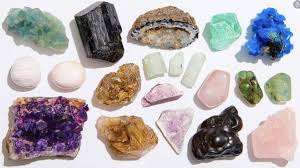The article gives a detail notes on Different types of Rock formation and Rock classification.
In geology, a rock is a cohesive, naturally occurring conglomerate of one or more minerals. These aggregates usually form identifiable and mappable volumes and are the fundamental building block of the solid Earth. In general, rocks are categorized into three main types based on the processes that led to their creation.
These three classes of rocks are: (1) igneous rocks, which are formed from magma that has solidified; (2) sedimentary rocks, which are made up of rocks fragments that have been precipitated from solutions or that have been derived from preexisting rocks; and (3) metamorphic rocks, which have been formed from sedimentary or igneous rocks. The most significant ones are chemical, mineralogical, and textural characteristics. These three classifications are then further separated into a plethora of groups and kinds.
Rock Cycle
Geologic materials cycle through many forms, including host rock types and mineral crystals. Temperature, pressure, time, and variations in the surrounding environment in the Earth’s crust and on its surface all affect the process. The fundamental connections between sedimentary, metamorphic, and igneous rocks are depicted in Figure 1’s rock cycle.
Weathering, or the physical and chemical disintegration of minerals, and transportation to a deposition location are two aspects of erosion. As previously mentioned, diagenesis is the process of producing sedimentary rock by the natural cementation of grains through compaction, crystallization from solutions or water, or recrystallization. Lithification is the process via which sediments turn into rock.
Rock formation due to forces:
- Exfoliation: A rock mass disintegrates layer by layer leaving behind smaller spherical bodies
and forming curve rock shell by disintegration through Spalling (heating and
cooling).
- Block Separation: It takes place in rocks with numerous joints acquired by mountain making
pressures due to heating and cooling.
- Shattering: A huge rock may undergo disintegration along weak zones to produce highly angular pieces with sharp corners and edges.
- Frost Action: During heat, water seeps in and in cold it freezes, resulting in fractures from
inside the rock.
- Mass wasting: The force exerted by gravity on all matter in different rocks.
-Rock classification
Rocks are generally classified by mineral and chemical composition, by the texture of the constituent particles and by the processes that formed them.
- Igneous Rocks: Igneous rock (derived from the Latin word igneous meaning of fire, from ignis meaning fire) forms through the cooling and solidification of magma or lava. Rocks classified as igneous solidify from magma, which is a molten mixture of minerals that form rocks and typically volatile substances like steam and gasses. Igneous rocks occur at high temperatures because the component minerals of these rocks crystallize from molten material. They come from deep-seated processes in the upper mantle or mid-to lower-crust, usually between 50 and 200 kilometers (30 and 120 miles) below the surface of the Earth. There are two types of igneous rocks: those that are intrusive (found in the crust) and extrusive (found on the surface of the land or ocean floor), in which case the molten material that is cooling is referred to as lava.
- Sedimentary Rocks: Sedimentary rocks are types of rock that are formed by the deposition of material at the Earth’s surface and within bodies of water. Rocks classified as sedimentary are those that have been deposited at the Earth’s surface and have been lithified—that is, crushed and cemented together—by ice, wind, water, or living things. The majority are deposited from the surface of the land to the ocean, lake, and river bottoms. In general, sedimentary rocks exhibit stratification, or layering. Layers can be identified by variations in cement type, color, size of the particles, or internal organization.
- Metamorphic Rocks: Metamorphic rocks arise from the transformation of existing rock types, in a process called metamorphism, which means “change in form”. The original rock
(protolith) is subjected to heat and pressure, (temperatures greater than 150 to 200 °C and pressures of 1500 bars) causing profound physical or chemical change.
Rocks that have undergone metamorphism are those that were created by intense heat, pressure, and chemically reactive solutions transforming previous rocks. Both physical (textural) and chemical (compositional) modifications are possible. New minerals, textures, and crystal formations are frequently produced by processes that occur deep below the Earth to generate metamorphic rocks.
The process of recrystallization occurs primarily in the solid state instead of through total remelting, and it can be facilitated by ductile deformation and the presence of interstitial fluids like water. The separation of minerals into distinct bands during metamorphism frequently results in the appearance of layering or banding. Pyrometamorphism, which happens close to coal seams that catch fire after being struck by lightning, can also cause metamorphic processes to happen at the Earth’s surface.


Comments are closed.